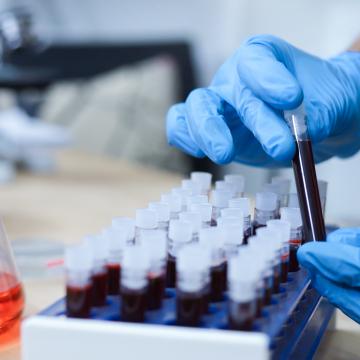Blood Stem Cell and Bone Marrow Transplants
City of Hope is one of the largest and most successful transplantation programs in the country, with more than 18,000 bone marrow transplant procedures performed to date—both autologous and allogeneic—through our cancer centers in Duarte, Phoenix, Chicago and Atlanta. And we're known for delivering exceptional survivor rates, according to the Center for International Blood and Marrow Transplant Research. Over the years we have consistently had outcomes that rank at the highest level among centers in this country.
City of Hope has long been a pioneer in creating breakthrough treatments for all hematologic cancers (leukemia, lymphoma, multiple myeloma and myelodysplastic syndrome) aplastic anemia, inherited blood diseases like sickle cell disease and other blood-related disorders. We are also a world leader in setting standards for stem cell transplantation and in improving long-term outcomes for both children and adults.
Our Expertise in Stem Cell Transplant
Our transplant program is accredited by the Foundation for the Accreditation of Cellular Therapy (FACT), the standard of excellence for blood and bone marrow transplant programs in the United States.
In addition, City of Hope's flagship hospital in Duarte, CA, has been designated by the National Cancer Institute as a comprehensive cancer center since 1998, and we are a founding member of the National Comprehensive Cancer Network (NCCN).
Our expertise includes autologous and allogeneic stem cell transplants, using cells derived from bone marrow, peripheral blood and cord blood.
Our physicians have extensive experience with a wide variety of transplant procedures, having performed more than 18,000 bone marrow and stem cell transplants to date — making City of Hope one of the largest programs in the United States.
Learn more about City of Hope's bone marrow transplant expertise
We recognize the importance of maintaining contact with all transplant patients to ensure they have optimal outcomes after their treatments have concluded. Established in 1998, our long-term follow-up program tracks patients who have received a transplant at City of Hope. Through this program, our survivors can be carefully monitored for long-term effects and given timely interventions, while our clinicians and researchers have access to data that they can use to improve cancer treatments further.
Learn more about our long-term commitment to transplant success
A Patient's Guide to Blood and Marrow Stem Cell Transplantation at City of Hope was developed to help our patients and their families learn about blood stem cell and bone marrow transplantation and what to expect before, during and after transplant.

At City of Hope, your supportive care continues long after treatment is complete. Our specialists will help you adjust to post-treatment diet and lifestyle changes, and our unique family and survivorship programs will assist you and your loved ones.

Our developments in the areas of breakthrough cancer drugs, bone marrow transplants and CAR T cell therapy are recognized internationally.

Our leadership in research and innovation continually enhances our ability to provide novel and differentiated approaches to cancer care.


